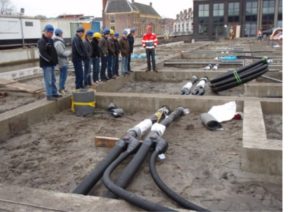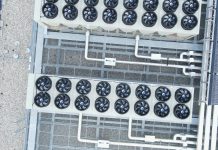 Municipalities and communities are driving heat network uptake in Europe. Can the UK follow the same path and how can costs be reduced? Water, Energy & Environment visited heat network pipe manufacturer Thermaflex to find out.
Municipalities and communities are driving heat network uptake in Europe. Can the UK follow the same path and how can costs be reduced? Water, Energy & Environment visited heat network pipe manufacturer Thermaflex to find out.
The department of energy and climate change states that it has “ambitious plans” for heat networks. But the industry wants more commitment if those plans are to become reality – and more support for communities trying to build them.
Decc’s heat map suggests around half of heat demand in England, or 8 million homes, is concentrated close enough to heat sources for heat networks to be worth investigating. The department recently allocated £3 million to 55 councils in England and Wales towards setting them up.
The aim is to develop proposed networks to a stage where they might be financeable. Decc has mooted Green Investment Bank involvement should the larger schemes be deemed feasible and bankable (and where the Investor Confidence Project might help).
Such funding is welcome, according to the district heating industry. But proponents want a bigger commitment.
Flexenergy sales director Sandy Fairley worries that the Decc funding may end up wasted.
There is a risk that £3 million “will produce nothing,” says Fairley, and end up simply an exercise in “ticking a box”.
“It will take a lot of money to take this forward. We need to reduce energy waste and we need to look at government policy,” he told trade press in Waalwijk, Holland, visiting insulated plastic pipe manufacturer Thermaflex, with which Flexenergy works in the UK.
Both firms would stand to benefit from any policy drive on heat networks. But so would the UK’s chances of hitting carbon targets at lowest overall cost, given around half of the UK’s energy use is attributable to heat.
According to Decc figures, there are around 2,000 networks delivering heat to some 210,000 dwellings and 1,700 commercial and public buildings across the UK. That represents somewhere around 2% of domestic, commercial and public heat demand.
In Holland, some 621,000 dwellings are connected. Authorities are building out networks and scheme owners are increasingly replacing the heat sources with renewable generation, according to Thermaflex CEO and owner Gerrit-Jan Baars. With 7 million households in the Netherlands, that equates to around 9% of dwellings connected to a heat network.
The difference in the Netherlands market is that many of the schemes are community or municipality owned, sometimes in conjunction with an energy company. Baars said that starting with smaller schemes and taking a decentralised approach is key to driving further adoption.
One of the barriers to uptake is cost, both in installation and maintenance. But Thermaflex claims its insulated plastic pipe networks can make installation faster – and therefore cheaper and less disruptive – as well as increase system life. Whereas steel pipe systems can start to break down after a decade due to corrosion, Thermaflex’s are certified for 50 years, said Baars.
“The things that break down first are the connections. If we can make them live for 50-100 years, then maybe the whole system can last that long.”
But he said that the network is the critical element, because the source can be replaced. In Holland there is currently swathe of heat source replacement being undertaken, with energy from waste sources being connected to formerly fossil fuelled schemes.
Flexatherm’s Fairley thinks that while upfront cost is a key barrier, some of those costs for heat networks may also be overcooked. “We see figures quoted of £1,000 per meter for networks. I know what the material costs, I know what it costs to dig up the road and install it,” he says. “It doesn’t add up to £1,000 a meter. So perception is something we need to try and challenge.”
But Baars said the firm is increasingly speaking with more and more communities and municipalities which do understand the long term benefits versus short-term cost burden, and who wish to take control of their heating costs. He thinks the shift towards a decentralised energy model will accelerate that process.
As local authorities such as Nottingham and Bristol step up plans to become fully licensed energy suppliers, and even energy network owner-operators, perhaps that kind of shift is already happening in pockets of the UK.
Flexenergy acts as the UK partner for Thermaflex, looking after the design, supply and implementation of UK schemes that use Thermaflex pipe technology. The flexible pastic pipework can be fully prefabricated for use in heat networks. Because of that the company claims to have connected an entire street to a district heating scheme in a single day, including remediation works.
Follow us at @EnergystMedia. For regular bulletins, sign up for the free newsletter.



